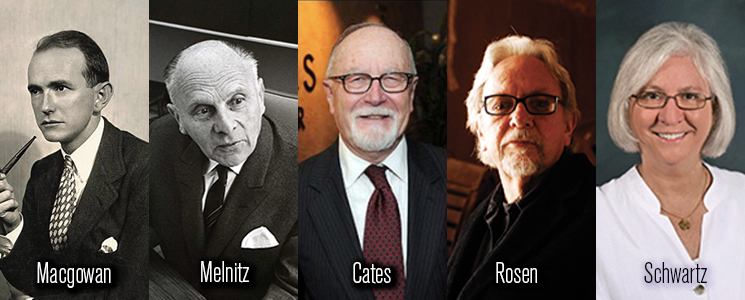UCLA School of Theater, Film and Television History
The study of drama first appeared on the UCLA campus as English Department classes in the College of Allied Arts in 1941. They provided fundamentals in public speaking, dramatic reading, set design and play production, among others. In 1947, the Theater Arts department was established with film producer Kenneth Macgowan (Little Women, 1933; Becky Sharp, 1935) as its first chair. One of his initial hires was William Melnitz, a German theater director émigré who had worked with the legendary Max Reinhardt, and who became the department's chair in 1953. In 1960 the department became part of the UCLA College of Fine Arts; Melnitz was its founding dean. For its first two years the department offered undergraduate study across three divisions: Theater, Motion Pictures and Radio. Developed in cooperation with the Academy of Motion Picture Arts and Sciences, the four major radio broadcasting networks in Hollywood, and the Associated Committee on Television, this arrangement marked the first time a leading university had brought together these distinct subjects under a single administration. It remains groundbreaking.
Melnitz spearheaded the building plan that enabled the College of Fine Arts to grow quickly in stature and create new facilities. In 1963, Theater took up residence in Macgowan Hall, and in 1967 the Department of Motion Pictures, Television and Radio moved into Melnitz Hall. Gradually, the departments became more specialized across disciplinary lines in educational, research and production activities.
In 1987 the College of Fine Arts was dissolved, and in 1990 the School of Theater, Film and Television was created with eminent film, television and Broadway director Gilbert Cates as its founding dean. Dean Cates set out to create a professional conservatory environment within UCLA, which by then was a dominant research university. With his guidance, new faculty were hired, curriculum was expanded and direct outreach to the entertainment industry was markedly increased.
Distinguished professor and film historian Robert Rosen became UCLA TFT’s second dean in 1999, after spearheading the growth of the UCLA Film & Television Archive into the world’s largest university-based media archive. In the United States, it is the second largest moving image archive after the Library of Congress. Dean Rosen built upon the foundation established and successes achieved by Dean Cates, expanding the School's international influence with robust alliances in China, in particular.
In 2009 UCLA TFT welcomed the arrival of Dean Teri Schwartz, a former award-winning feature film producer, founding dean of the Loyola Marymount University School of Film and Television and a UCLA alumna. Dean Schwartz had a new vision for UCLA TFT and she launched a long-range plan for the 21st century that not only built upon the rich legacy, traditions and successes of her predecessors, but differentiated UCLA TFT by re-imagining entertainment and performing arts education as an interdisciplinary enterprise grounded in humanistic storytelling, technology and innovation, global diversity and social responsibility.
Under Dean Schwartz’ leadership, the School created innovative programs and curriculum, recruiting outstanding faculty, staff and students, re-imagining its facilities and technology and connecting UCLA TFT even more robustly to its alumni, the entertainment and performing arts industries, the campus, city and world.






